originally posted at https://canmom.tumblr.com/post/687931...
So, I have finally seen Grave of the Fireflies! (And watched Totoro for the… not even sure, n+1th time.) For comments before the film, see Animation Night 111.
Anyway, what a fascinating range that was. I went into Fireflies not know much more than the premise - two children die in the war - and to expect an extremely sad movie. So, let me talk about some things that stood out to me, compared to that expectation. And then, I want to lead into a comparison to some very similar films, namely Barefoot Gen and In This Corner of the World…

So. The first surprise - perhaps it shouldn’t be a surprise, given we’re talking about Takahata here - is how understated it is. It does use music, but only sometimes. In contrast to the exaggerated emotions and stretchy faces of Totoro, characters are mostly quite stoic. It’s not to say that characters do not emote at all, as in many of Mamoru Oshii’s films - indeed, the film may be the first to contain the iconic Ghibli tears running down a character’s face - but a lot of the time, we are led to infer the emotional context from the characters’ actions, the scenario, and the framing of the scenes.
Grave of the Fireflies opens with the death of the boy Seita. He is one of a number of starving, listless children in what I think is a train station. Even before his death, he barely responds to interaction or offers of food, and before long he dies. A uniformed man finds his body, but does not seem to find it remarkable - children dying here is a regular occurrence. He finds a sweets tin, and can’t work out what’s inside it - it is only much later that we find out the tin contains ashes of Seita’s sister Setsuko, who starved to death under his watch, and the tin becomes a symbol of their relationship through the rest of the film. Seita and Setsuko’s ghosts rise from the tin; the rest of the film is a flashback, showing the circumstances in which Setsuko died.
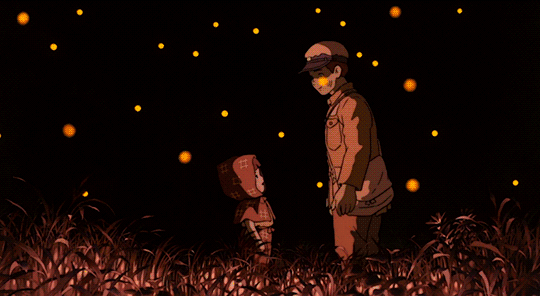
The film is based on a short story written in 1967 by Akiyuki Nosaka. It is semi-autobiograpical; in reality, Nosaka lost three family members during the war: one sister to illness, his father to the firebombing of Kobe, and then his younger sister Fukui to malnutrition; the story is framed as an apology to Fukui for her death. So in a most direct sense, Seita represents Akiyuki Nosaka, and Setsuko represents Fukui. The story is written in the tradition of ‘double suicide’ stories, more typically about lovers. It is in a way quite abstracted: Nosaka spoke of writing about an ‘idealised humanity’ in an ‘idealised situation’ in contrast to his feelings about the culture of 1967.
If you read the wiki article there, almost all of what we read is Takahata’s interpretation; it’s safe to say his film has heavily overshadowed the original story in memory. So let’s look at his connection to it.
Takahata was born in October 1935, so he would have been nine, approaching ten years old when the war ended. He had also survived a US air raid, on Okayama in June 29, but it seems he did not lose family to the war. However, as his later films would show, he is very concerned with cultural memory, and things being lost: the protagonist’s memories of her rural childhood in Only Yesterday, or the tanuki forest being cut down in Pom Poko.
So, by the time of Grave of the Fireflies being released, Takahata was already 53 years old. In the context of the 80s economic boom, he evidently saw himself as belonging to a different era; there’s something of a ‘kids of today!’ angle in how he spoke about the contemporary generation in the 1987 interview that forms the basis for most of that article..
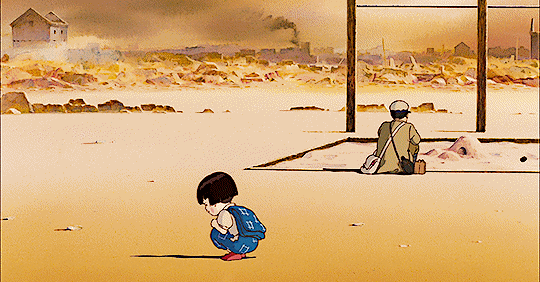
There are two other obvious films to compare this one to - both dealing with children living through the war, and the time afterwards. Historically, the most relevant one is Barefoot Gen (はだしのゲン), which we watched back on Animation Night 26. This is based on a manga by Keiji Nakazawa, a survivor of the Hiroshima bombing, but it’s equally concerned with the brutal period right after the war, serialised from the period 1973-1987. The manga began serialisation in Weekly Shōnen Jump but stayed there only one year where it proved unpopular with readers, before moving to leftist publications like Citizen’s and Cultural Criticism; it was enjoyed a lot by Art Spiegelman of Maus fame. You can read it here on archive.org.
In the introduction, Nakazawa writes that many of the awful scenes in the story are directly autobiographical; he says:
1966, after seven years of illness, my mother died in the A- Bomb Victims Hospital in Hiroshima. When I went to the crematorium to collect her ashes, I was shocked. There were no bones left in my mother’s ashes, as there normally are after a cremation. Radioactive cesium from the bomb had eaten away at her bones to the point that they disintegrated. The bomb had even deprived me of my mother’s bones. I was overcome with rage. I vowed that I would never forgive the Japanese militarists who started the war, nor the Americans who had so casually dropped the bomb on us.
Barefoot Gen was adapted to two anime films by Madhouse in 1983 and 1986; at the time the mighty Osamu Dezaki had just departed in 1980, and so under Masao Maroyama, Madhouse was becoming much more auteur-driven studio with an increasingly diverse output with figures like Rintaro coming into their own. The two Barefoot Gen films are directed by first Mori Masaki and then Toshio Hirata.
Compared to Grave of the Fireflies, the approach taken to animation in Barefoot Gen therefore comes from the Mushi-Pro/Dezaki lineage rather than the Toei lineage. It’s much less concerned with realism in character animation, taking a more exaggerated approach to motion with a lower drawing count that at least to my eye calls back to the Kanada school, but also the Dezaki visual language and drive towards going all-in on presenting emotion seen in works like Ashita no Joe. Which is certainly not to say that Barefoot Gen is completely lacking in moments of subtler animation, like a doctor washing his hands after taking care of a patient or Gen carving wood; it’s just not the overwhelming focus of the film like Takahata’s work. Despite the harsh circumstances, most of the early parts of the film end with the characters laughing and a fade to black.
Then the bomb drops.
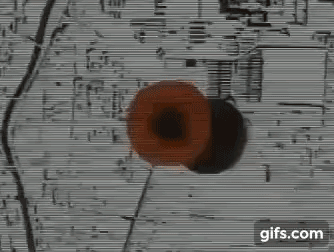
When it comes to the Hiroshima bombing Barefoot Gen does not at all hold back on detail; it is not exactly realism but it clearly draws heavily on nuclear bomb test footage. The moments leading up to the bombing are excruciating anticipation: the characters dismiss the ‘spy plane’ and talk about the weather, and then we cut to radio chatter in English between the observation planes and the Enola Gay discussing the weather in a horribly different light. The planes are drawn in exacting detail, and we’re shown supernatural omens like ants crawling inside. Then, we see the bombing through the scope of the plane; the pilots are drawn in a heavily hatched style with realistic proportions reminiscent of an American comic. The bomb drops, and the mushroom cloud rises silently as an expanding circle; then we see a series of shots abruptly switch into harsh black and white shadow shapes. Like in Grave of the Fireflies, they are using the techniques of cel shading to show form through shape, but with the contrast pushed up to maximum.
In the 80s OVA era, Madhouse would become experts at drawing monsters, but Gen actually predates most of these well-known works. Nevertheless, it delivers a huge amount of grotesque imagery: a chain of shots showing characters we have grown to like over the course of the film being melted away, their eyeballs falling out, etc. All of these are drawn with a low framerate, and there isn’t too much concern for realism, but that might be the point. All of these scenes are shown in vivid, hypersaturated colours against a swirling paint background.
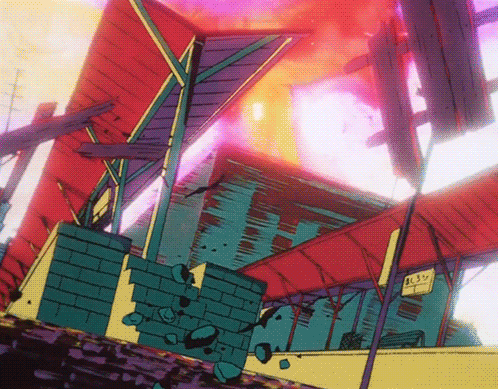
Following this the rest of the film is a series of further horrors as Gen loses his family trapped in a burning building (an event directly experienced by Nakazawa) and stumbles alone through the city, witnessing the injuries of survivors (who stumble out of the ruins like zombies), and then the effects of radiation poisoning. It is a harrowing film; it never looks away. The focus on rubbing our face in horror and gore could feel voyeuristic, especially in the context of later OVAs which are pretty gleeful with their violence, but here - perhaps because of how it is framed by narration - it achieves an appropriately sickening effect. After all, even if it didn’t look like this, this really happened: there was an instant in 1945 where thousands of people had their flesh melted like this all at once. Animation here is used to slow down time and show the effects of the bomb in even more excruciating detail than live action could manage.
The focus of the first Barefoot Gen film is therefore the horror of the Hiroshima bombing. This wasn’t a completely unprecedented subject in film, with prior Japanese examples including the Japan Teachers Union funded Children of Hiroshima (1952) and Hiroshima (1953), and Barefoot Gen had already seen a live-action adaptation in 1976, but as I understand it was still at least something of a taboo subject; later in the 80s would come films like Black Rain (1989). The manga goes much further, telling the story of Gen’s life in the aftermath of the war, but the first film (reasonably) makes the decision to spend its runtime on Gen’s life leading up to the bombing and its immediate impact.
The second film adapts later parts of the manga, following Gen’s life in the years after the war - but if the first film was hard to acquire, the second is essentially impossible. So sadly I can’t comment on this one.
Grave of the Fireflies also has scenes of bombing, primarily at the beginning, with the firebombing of Kobe. Waves of firebombs fall like seeds and bounce off buildings to scatter in the street - in contrast to the expected explosions, it is a surprisingly quiet scene which gradually builds up into an emergency. There is one brief aerial shot, but for the most part, planes are seen from a distance.
Compared to Seita, who is caring towards his sister but quietly very proud, and who idolises his sailor father (who is fighting at sea and implicitly dies offscreen), Gen is a lot more energetic and playful. Gen’s father is also a completely different figure: the film is at pains to show that he is opposed to the war, which reflects Nakazawa’s real father, who was arrested and imprisoned for his involvement in an anti-war theatre troupe. Without knowing this context, the film can come across as somewhat idealised, painting the father as opposed to the war to make it easier to sympathise with him. But no, that’s real.
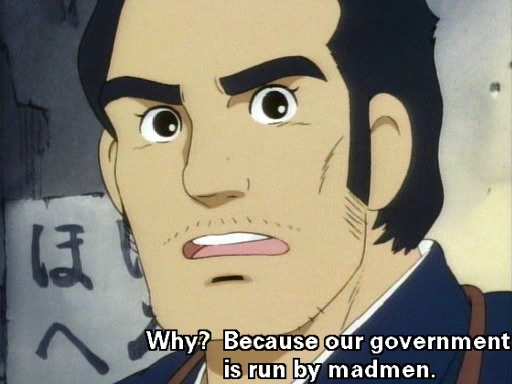
(please forgive the off-centre subs; it is almost impossible to find a good encode of this movie and the alternative is subs that are bright purple!)
In contrast, both Grave of the Fireflies and much later In This Corner of the World portray how much of the population did indeed hold nationalist sentiments and hope for Japan’s victory in the war. Seita acts as as a synecdoche for the forgotten children starving to death in the station, but he also represents a certain stupid stubbornness: rather than swallow his pride and return to his asshole aunt, he starves to death along with his sister. In one striking sequence, sitting in a hole in the ground, Seita sings to himself a patriotic song about Japan seeing off invaders near and far, and imagines a sequence where his dad sails past on a huge warship bedecked in lights, mingling with the symbol of the fireflies. It is a child’s view of the war, but he is after all a child. And sure enough, his dad almost certainly dies at sea; we do not find out for sure, only that he never returns Seita’s leters.
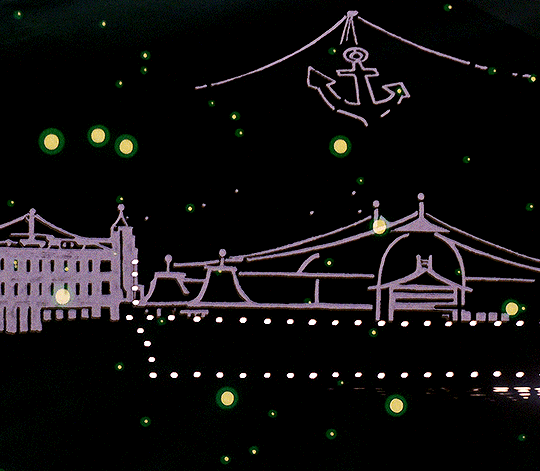
The archetype of a brother struggling to protect a sickly sister is a classic one - in recent years we’ve seen characters like Nier and whatever the kid from Demon Slayer is called - but here, Seita completely fails to live up to this. He can’t save his sister, and the failure kills him too.
Food is a huge concern of both films: because it is in such short supply, what little is available is all the more important. The loving rendering of food that Ghibli is known for began in Castle in the Sky, but it attains special significance here, with items like fruit drops and white rice becoming treasured items. Similar is true in Gen: a major plot point concerns Gen and his brother stealing a fish to give to their sick mother, and a kind fisherman letting them keep it.
And, for the most part, adults in Gen are kind, and proud of the children. This is absolutely not the case in Grave of the Fireflies. Here, the adults are just about universally indifferent to Seita and Setsuko’s plight. Their aunt berates them as other mouths to feed who don’t work in return, sees Seita’s decision to buy a stove as a stubborn refusal rather than an attempt to accommodate, and simply lets them go when Seita decides to leave to an unknown destination. The local farmers soon run out of rice to sell, and so Seita resorts to theft, which gets him beaten. The doctor diagnoses Setsuko’s malnutrition, but has no suggestion of where she’ll get food. About the only time they do receive a gift is after Setsuko’s death, where one of the farmers has a ready supply of charcoal to burn her corpse.
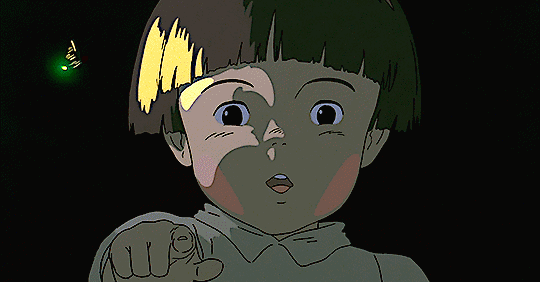
Since Grave of the Fireflies is adapting a short story rather than a long-running manga, it has generally fewer events to cover, and can proceed at a slow pace. The story is simpler: it is not trying to show all the horrors of the bomb, but merely make us bear witness to the story of these two children.
The final image of Grave of the Fireflies shows Seita and Setsuko’s ghosts looking out on a modern Japan with new high-rise buildings - implicitly one that has completely forgotten them. The painfully beautiful but short-lived fireflies are a recurring image; early on, Setsuko crushes a firefly by accident, and the title of the film refers to a point where the children capture a number of fireflies and release them to light their shelter, but by morning they are dead; Setsuko digs a small mass grave and puts the fireflies in it. Later, Seita will burn her corpse, and the grave marker comes to correspond to her as well. The symbolism is very direct, but the way it is executed - that fascination with light - makes it work.
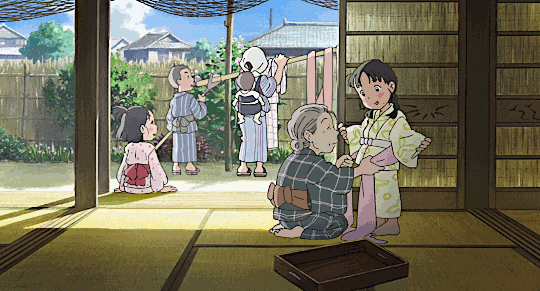
In This Corner of the World (2016) comes much later in this lineage. Unlike the previous two films, it is not based on anyone’s direct experience of living through the war. Instead, the impetus comes from mangaka Fumiyo Kōno’s editor, who asked her to write a story about the Hiroshima bombing. Kōno is a resident of Hiroshima born in 1968, but none of her family are bomb survivors; she was not initially moved by the suggestion, but changed her mind after realising how the bombing had become a taboo subject, not even remembered by many people in the city. This led to her manga Town of Evening Calm, Country of Cherry Blossoms (夕凪の街 桜の国, 2004). WP writes:
According to Fumiyo Kōno’s afterword, she was prompted to write Town of Evening Calm, Country of Cherry Blossoms when her editor asked her for a Hiroshima story. She was initially reluctant because, while she was born in Hiroshima neither she nor anyone in her family was a survivor of the atomic bomb, and growing up she found the subject upsetting and had tried to avoid it ever since. She decided to tackle the subject because she felt it was “unnatural and irresponsible for me to consciously try to avoid the issue.” Living in Tokyo, she had come to realize that people outside of Hiroshima and Nagasaki didn’t know about the effects of the bomb, not because they were avoiding the subject but because it is never talked about, and so she attempted the story because “drawing something is better than drawing nothing at all.”[9]
Kōno described “Country of Cherry Blossoms” as “what I most needed to hear two years ago, when I still avoided anything to do with the atomic bomb.”[9]
Town of Evening Calm, Country of Cherry Blossoms is a two part manga, about two generations of descendants of bomb survivors. She followed this manga up in 2007-2009 with In This Corner of the World (この世界の片隅に), following a young artist called Suzu who lives in Hiroshima and nearby , during the war.
Kōno credits a series of inspirations, many of them old school manga artists:
She feels that Osamu Tezuka and Fujiko Fujio were among her early influences, but then she was inspired by Sanpei Shirato’s literary style and at present, she takes inspiration from Yu Takita’s versatility.
Tezuka needs no introduction. Fujiko Fujio is the pen name of a pair of manga artists who started writing in 1960, notably creating Doraemon. Shirato is a pioneering gekiga artist who frequently contributed to Garo magazine. Yu Takita was another Garo mangaka, known for autiobiographical manga, though I can’t find much more than this.
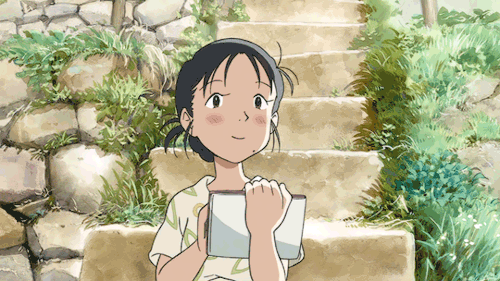
In 2016, this film received an adaptation directed by Sunao Katabuchi, known for Princess Arete (Animation Night 74). The animation was carried out at Mappa, who are funnily enough an offshoot of Madhouse, as well as outsourcing to Madhouse proper and DR Movie - however their approach calls to mind much more Takahata. The character designs are not nearly so solid and detailed, instead going for a more abstract and simplified style that follows the manga, but the approach to movement is very much in the realist school, with lots of carefully observed, subtle everyday actions.
Many scenes seem to draw heavily on Grave of the Fireflies, such as when the characters witness an enormous ship come into port and slide gradually past the camera, elaborately animated food preparation, a scene where a character ducking for cover in a field sings a patriotic song, a precious supply of white rice. Other scenes, such as aerial shots of bombs falling, step closer to Barefoot Gen. Actually all three films have a scene where a plane strafes the ground where a character is running and they have to dive for cover!
Compared to the other two films, In This Corner is less concerned with foregrounding the horrors of war and death, though it is absolutely interested in the emotional experience of war. There are certainly plenty of scenes where the main character has to duck from air combat; she loses her drawing hand and narrowly escapes death from a burrowing bomb. But it’s also deeply concerned with the romance plot, and the longer arc of a life. It wants to show not just the experience of the war, but the experience of moving past it.
One key moment not explored in the others comes with the announcement of Japan’s surrender. In Fireflies, Seita hears about this from a man in a queue to withdraw his mother’s money at a bank - he demands to know whether his father survived and flees but that’s really the end of it, since it leads right into the death of Setsuko. By contrast, In This Corner shows the whole family listening to the radio as the surrender is announced, and explores how Suzu is appalled to realise that everything she went through was for absolutely nothing; this is soon followed by the revelation that her parents are respectively killed by the bomb and dying of radiation poisoning.
The film continues after the end of the war for some time, heavily compressing time now, following Suzu adopting a child and gradually regaining a will to live. In a flashback scene it does show the bombing, and the child holding the corpse of their mother crawling with maggots and pierced with broken glass, but even here the drawing of injury is much less meticulously detailed than in either of the other films.
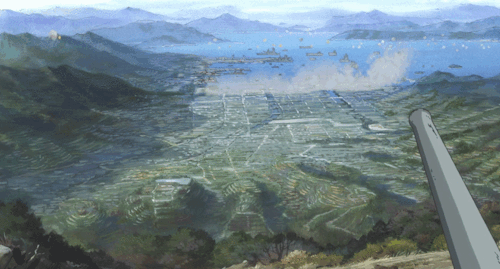
As far as depicting warfare, In This Corner uses CGI for some of the scenes of planes and bombs; it’s not especially jarring but it is a little noticeably different, and actually quite elaborate. There are some interesting bits of stylisation like the colourful bursts of explosions. Ships, on the other hand, are hand-drawn, and there’s an interesting balance between the detailed accuracy to the historical vessels and a certain sketchiness. The backgrounds have noticeable brushwork texture - they’re very strong in general, both more stylish and more detailed than Mappa’s TV backgrounds.
The most noticeable difference in aesthetic brought by 30 years is the use of digital ink and paint, and the looseness of shapes. I think the designs are quite closely based on the manga, which uses rough lines and watercolours; what it means in practice here is simplification and abstraction of shapes.
Oh, and of course… In This Corner is a much longer film than the other two, which both come in sub 90 minutes while the extended cut of In This Corner (which I haven’t seen) is literally the longest animated film ever made at 168 minutes; even the original cut more than two hours. This is in part perhaps reflecting different production conditions (making Totoro and Fireflies side by side strained the resources of Ghibli as it is, while Mappa are a large - if incredibly overworked - studio in a totally different era), and norms about how long a film should be. The longer runtime gives In This Corner time to do more, but it also makes it less pointed about any one thing.
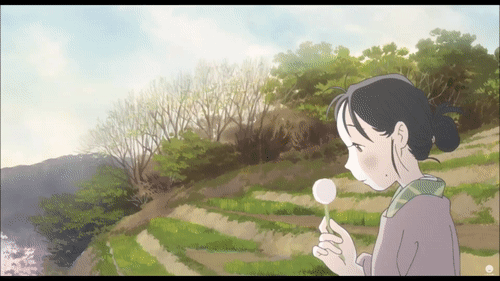
In terms of the emotional tone of the three films, Barefoot Gen is a very angry film: it wants you to be confronted with the full horror of what happened and share in the author’s furious disgust towards the Japanese government and American bombers. But it’s also, perhaps surprisingly, a hopeful film that wants us to believe none of this is inevitable - as Spiegelman’s intro the comic describes it, an expression of the worldview that let the author carry on after going through a literal nuclear bombing.
Grave of the Fireflies is more a film about remembrance. Seita is a tragic figure, but we’re invited to understand him much more than condemn, and see what could lead to a girl dying in a hole in the arms of her brother. Its gaze is cold, almost clinical, precisely absorbing every detail. There is no living on after the war: just two ghosts watching a world become unrecognisable. There is very little that is hopeful to be found here; at best the wistful thought that all these people lost to time and entropy might live on as ghosts. But that is what gives the film its force.
In This Corner of the World expresses a different generation’s attempt to dig into a war that predates our births. It is the view of someone who cares a lot about portraying it right, and Katabuchi certainly excels at portraying wistfulness and loss of motivation, but it is also inevitably a view from afar, and to me that means it feels like it ends up being less bold in its artistic choices than the other two - though that could simply be because it reflects the tastes of this era, and not a past one! ‘Less bold’ absolutely does not mean ‘bad’; it’s still a moving and truthful picture, and it was definitely the film I needed to watch after Gen and When The Wind Blows two years ago. As much as it’s rooted in history, its story is ultimately a personal one, about the course of a life, and I suppose about committing to a future despite incredible adversity.
Taking all three films… like, this isn’t about trying to pick a ‘best’ one. They all complement each other, and it is deeply fascinating to see how many different ways you can effectively approach the same period and even the same subject matter, and also I suppose a case study in seeing how 30 years changes the way we tell a story about one of the worst periods of history. By this point, the number of people who remember WWII is dwindling; we are left with artworks to get a sense of how they understood it, and then if it is relevant we try to connect to that history with our own artworks.
Perhaps it would be worth digging into other significant manga that deal with this period - I think for example Suehiro Maruo wrote quite a bit about orphans in the aftermath of the war. But that’s a discussion for another day…
(If you read all this… thank you. This isn’t really going to be a regular feature or anything, I just had a bunch of thoughts I wanted to write down after that movie, and I wanted to give it a more detailed treatment than I could in a couple of hours before the film!)
Comments